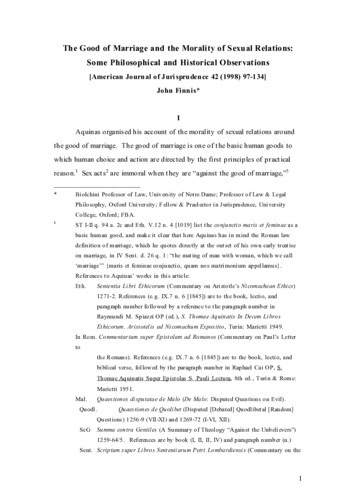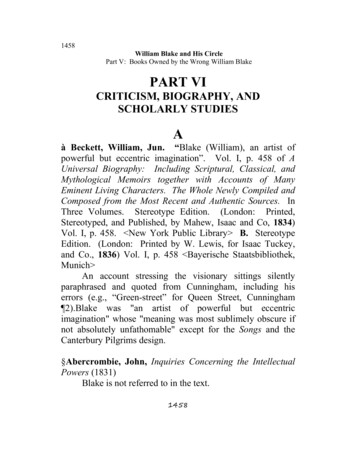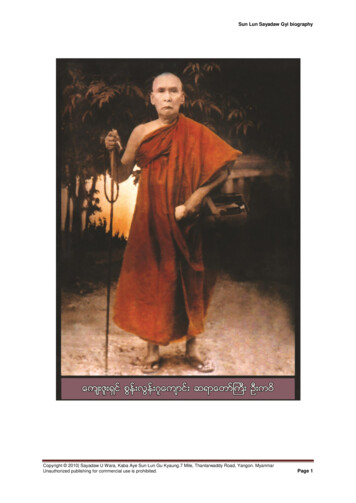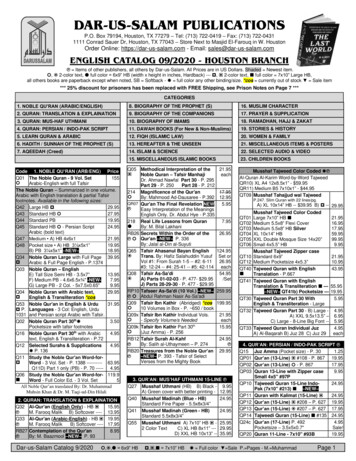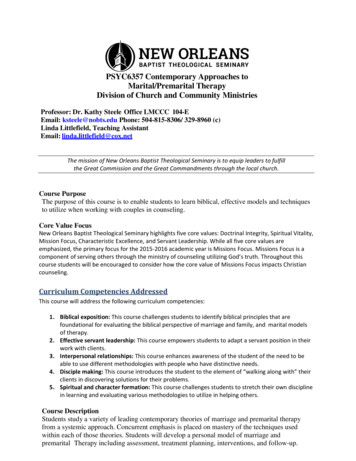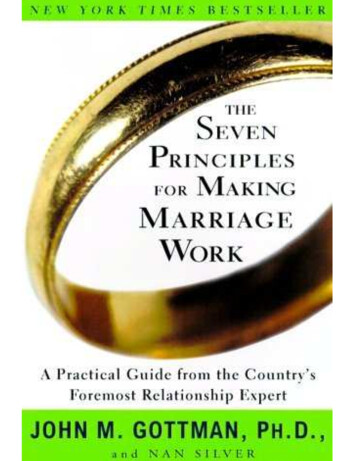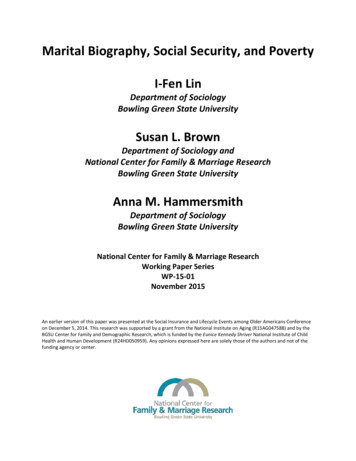
Transcription
Marital Biography, Social Security, and PovertyI-Fen LinDepartment of SociologyBowling Green State UniversitySusan L. BrownDepartment of Sociology andNational Center for Family & Marriage ResearchBowling Green State UniversityAnna M. HammersmithDepartment of SociologyBowling Green State UniversityNational Center for Family & Marriage ResearchWorking Paper SeriesWP-15-01November 2015An earlier version of this paper was presented at the Social Insurance and Lifecycle Events among Older Americans Conferenceon December 5, 2014. This research was supported by a grant from the National Institute on Aging (R15AG047588) and by theBGSU Center for Family and Demographic Research, which is funded by the Eunice Kennedy Shriver National Institute of ChildHealth and Human Development (R24HD050959). Any opinions expressed here are solely those of the authors and not of thefunding agency or center.
Marital Biography, Social Security Receipt, and PovertyAbstractIncreasingly, older adults are unmarried, which could mean a larger share is at risk ofeconomic disadvantage. Using data from the 2010 Health and Retirement Study, we chart thediverse range of marital biographies, capturing marital sequences and timing, of adults who areage eligible for Social Security and examine three indicators of economic well-being: SocialSecurity receipt, Social Security benefit levels, and poverty status. Partnereds aredisproportionately likely to receive Social Security and they enjoy relatively high Social Securitybenefits and very low poverty levels. Among singles, economic well-being varies by maritalbiography and gender. Gray divorced and never-married women face considerable economicinsecurity. Their Social Security benefits are relatively low and their poverty rates are quite high(over 25%), indicating Social Security alone is not sufficient to prevent these women fromfalling into poverty. By comparison, late widoweds are the most advantaged singles.Key words: gender, gray divorce, marital biography, poverty, Social Security
Dramatic changes in U.S. family life are evident across the life course. Perhaps the mostfundamental shift is that a growing share of midlife and older adults is unmarried (Lin & Brown,2012; Sassler, 2010). Although widowhood is less common nowadays, gray divorce is on the rise(Brown & Lin, 2012). And, those who form unions in later life are increasingly likely to cohabitrather than marry (Brown, Bulanda, & Lee, 2012; Vespa, 2012). This retreat from marriageamong middle-aged and older adults has wide-ranging consequences for individual health andwell-being (Dupre & Meadows, 2007; Hughes & Waite, 2009; Pienta, Hayward, & Jenkins,2000). An extensive literature links marriage with numerous benefits, and foremost among theseis financial resources (Wilmoth & Koso, 2002; Zissimopoulos, 2013). The declining share ofolder adults who are married raises critical questions about the role of changing maritalbiographies for later life economic well-being.As more adults confront old age alone, how do they fare economically? In particular, towhat extent do public programs such as Social Security help to mitigate economic disadvantagefor unmarried older adults? The increasingly varied marital biographies of the older adultpopulation are potentially altering usage patterns for various federal programs such as SocialSecurity (Iams & Tamborini, 2012; United States Government Accountability Office, 2014). Atthe same time, Social Security was designed during an era when most elders were married, ascenario that is less common today and is likely to be even less typical in the future. In fact, thedecline in marriage is linked to reduced spouse and widow benefit eligibility for Social Securityamong women (Tamborini, Iams, & Whitman, 2009). This is particularly concerning given theoutsize role that Social Security plays in economic well-being for many Americans, particularlythose who are poor. Moreover, poor elders are disproportionately single women (Torres, 2014).Using data from the 2010 Health and Retirement Study, we address how marital
biographies, capturing marital sequences and timing, are related to Social Security benefits andto poverty. Our goal is to describe marital biographies for adults who are age eligible for SocialSecurity benefits (i.e., over age 62), emphasizing the diversity among the unmarried population.We move beyond the traditional, narrow emphasis of much gerontological research that hasfocused on marriage and widowhood to encompass other unmarrieds: cohabitors, the separatedand divorced, and the never married (de Jong Gierveld, 2004). In addition to capturing thesequencing of marital status by examining marital history pathways (e.g., remarried followingdivorce versus widowhood), we consider whether the timing of marital dissolution matters bydifferentiating between dissolutions that occurred before versus after age 50. This approachallows us to evaluate the potential impact of a gray divorce, which is an increasingly commonbut still off-time event, versus divorce that occurs earlier in the life course. Similarly, we canevaluate whether early widowhood (prior to age 50), a nonnormative event, is more detrimentalto economic security in later life than widowhood after age 50. Unmarrieds are examinedseparately by gender because unmarried women tend to have lower economic well-being thanunmarried men (Holden & Smock, 1991).BackgroundOlder adults enjoy the lowest overall levels of poverty largely because of the socialinsurance provided by programs such as Social Security, which are critical to economic wellbeing, especially for those who are economically disadvantaged. Nevertheless, poverty levelsvary by marital status among late middle-aged and older adults with singles four times as likelyto be poor as marrieds (Lin & Brown, 2012; Holden & Kuo, 1996). Further, single women aremore likely to be poor than single men. These differentials partially reflect the rules governingthe distribution of Social Security benefits, which rest on the now outmoded assumption that
nearly all adults marry and remain married until spousal death. Couples who divorce can accessspousal benefits provided they were married at least ten years and they do not remarry before age60. But, the share of divorced women who qualify for spousal benefits is projected to decline forsuccessive cohorts (Tamborini & Whitman, 2010). This is especially troubling because amongolder unmarried women, the divorced are most likely to be poor, followed by never-marrieds,and lastly widows (Butricia & Smith, 2012). And, we can expect the shares of single womenwho are either divorced or never-married will increase in the coming years (Lin & Brown, 2012).Lowering this 10 year marriage rule by just a few years would substantially reduce povertylevels among low-income divorced women, according to a recent study (Tamborini & Whitman,2010). The salient role of Social Security for the economic well-being of the most vulnerableelders underscores the need to examine how older adult marital biographies are linked to notonly Social Security receipt and benefit levels but also poverty.Marital BiographiesPrior research demonstrates that older adult economic well-being varies by marital status(Gustman & Juster, 1995; Seigel, 1993), but the work to date has not adequately captured the fullrange of marital histories characterizing older adults (Holden & Kuo, 1996; Wilmoth & Koso,2002; Zissimopulos, Karney, & Rauer, 2008). Moreover, most research on the enduring legacyof marital transitions is now rather dated (drawing on the 1992 HRS) and thus is not necessarilyreflective of the financial circumstances of today’s older adults, who have more diverse maritalbiographies compared with earlier generations (although see Addo & Lichter, 2013). Prior workhas focused on sequencing of marital events but ignored the timing of transitions. Finally, veryfew studies have examined either Social Security or poverty status according to maritalbiography. Our goal is to consider how various marital biographies that encompass both the
sequencing and timing of marital transitions are related to economic security among older adults.From a life course perspective, we anticipate that one’s marital biography is more salientfor well-being in later life than a simple measure of current marital status because maritalbiography captures the sequencing and timing of life events that contribute to the accumulationof (dis)advantage (O’Rand, 1996; Wilmoth & Koso, 2002). One’s marital biography also isassociated with eligibility for various types (e.g., spousal, survivor) of Social Security benefits,shaping the magnitude of the overall level of benefits received. Marital biography is relevant forpoverty status. For example, among the currently married, those ever widowed are more likely tobe poor than those in a first marriage. There is no comparable penalty for ever divorced currentlymarrieds (Holden & Kuo, 1996).Partnered Older AdultsA majority of older adults are married and marriage is associated with economicadvantage. The continuously married enjoy higher levels of economic well-being than remarriedcouples in late midlife (Addo & Lichter, 2013; Holden & Kuo, 1996; Wilmoth & Koso, 2004).Unlike those who have experienced marital dissolution, the continuously married have had alifetime together to accumulate resources. In contrast, those in remarriages have had to surmountthe financial shock that often accompanies marital dissolution. The remarried are alsodisadvantaged compared with the continuously married because of their shorter average maritaldurations and competition for resources that support prior unions. Nevertheless, all marriedspresumably benefit from economies of scale. In fact, men and women can often achieve predivorce levels of financial well-being through repartnering (Jansen, Motelmans, & Snoeckx,2009; Wilmoth & Koso, 2002).The number of older adults who co-reside with a partner outside of marriage is
skyrocketing with close to three million individuals ages 50 and older cohabiting in 2010 versusless than one million in 2000 (Brown et al., 2012). Cohabitation allows older adults to enjoymany of the benefits of marriage without the legal constraints (Chevan, 1996; Hatch, 1995). Inparticular, individuals point to the economic autonomy afforded through cohabitation thatenables them to protect their assets for the next generation. Cohabitors can continue to receive aformer spouse’s benefits, such as Social Security, that would not be available were they toremarry. One study indicated that cohabitors may be largely comparable to their marriedcounterparts in terms of economic well-being (Brown et al., 2006), although another found thatcohabitors were more economically disadvantaged, on average, than either continuously marriedor remarried couples (Wilmoth & Koso, 2002). The prevalence of poverty among oldercohabitors appears similar to that for single older adults (Chevan, 1996).Unpartnered Older AdultsRoughly one in three Baby Boomers is unmarried in contrast to just one in five midlifeadults in 1980 (Lin & Brown, 2012). Even at midlife, unmarrieds tend to be worse off comparedwith their married counterparts. The share of Baby Boomers living in poverty is nearly five timeshigher among unmarrieds (19%) than marrieds (4%). Whereas marrieds enjoy a medianhousehold income of over 105,000, unmarried Boomers are in households with a medianincome of about 57,000. There was some variation among unmarrieds, with widowed womenand never-married men most vulnerable, on average (Lin & Brown, 2012).The marital status composition of older adults has shifted in recent decades such that alarger proportion is divorced and a smaller share is widowed (Manning & Brown, 2011). Earlyresearch indicated that divorce and widowhood have comparable, negative ramifications foreconomic well-being in late mid-life (Holden & Kuo, 1996). Couch and his colleagues (2013)
considered the earnings trajectories and initial Social Security benefits experienced by womenwho divorced prior to age 41 during the 1970s. They found that women who divorced and didnot remarry enjoyed a higher earnings trajectory than either continuously married women ordivorced women who remarried. Divorced women who did not remarry claimed Social Securitybenefits at later ages, on average, and had the highest initial benefit level, too. Nonetheless, theoverall economic picture for divorced women remains grim since they do not have a spouse whois also drawing Social Security. Continuously married and remarried women typically have moreeconomic resources because of the husband’s contributions.Prior research on economic well-being in later life has overlooked gray divorce (i.e.,divorce after age 50), an increasingly common event. Gray divorce has doubled since 1990 eventhough the overall U.S. divorce rate remains stable (Brown & Lin, 2012). Gray divorce is morecommon among remarrieds, the less educated, and those with fewer economic resources. Theconsequences of gray divorce are unknown, but it is likely that this experience could havedevastating financial consequences for those who have been out of the labor force (e.g., stay-athome wives) or have few economic resources.TimingThe timing of marital dissolution in the adult life course may have implications for postdivorce adjustment, including late life economic well-being. Divorce tends to be more normativeat younger ages whereas widowhood becomes increasingly likely with age. From a life courseperspective, the timing of an event can magnify or reduce its influence on well-being (Elder,1994; Uhlenberg, 1996). Off-time events are associated with poorer outcomes than on-timeevents. Thus, divorce prior to age 50 may be less detrimental to economic well-being thandivorce after age 50. Those who divorce earlier in adulthood have more time to recoup the
financial losses divorce usually entails. In contrast, those who divorce later have fewer years ofworking life remaining and may not be able to fully recover economically from a gray divorce.Indeed, gray divorce appears to diminish wealth more than an earlier divorce (Zissimopoulos,2013). Similarly, widowhood prior to age 50 is an off-time event that is not a normative lifecourse experience. Young widows are more likely to become poor compared with older widows(Holden, Burkhauser, & Feaster, 1988). Couples tend to be overly optimistic about the likelihoodthey both will survive to an old age (Holden & Kuo, 1996). Thus they may not have adequatelyplanned for this unlikely possibility and ultimately may be less able to recover fully.The Role of GenderWomen are economically disadvantaged compared with men and this gender disparitywidens with age. Despite rising female labor force participation in recent decades, a majority ofwomen receive Social Security through spousal or widow benefits rather than on the basis oftheir own contributions (Meyer, Wolf, & Himes, 2006). Given the broader retreat from marriage,fewer older women may be eligible for spousal or widow benefits, whether because theydivorced less than ten years into their marriage, they did not remarry, or they never married inthe first place. These shifts in women’s marital biographies are linked to reduced benefits levels(Tamborini et al., 2009). For these reasons, we anticipate that marital biographies will play alarger role in the economic well-being of older women than men, an expectation that aligns withresults from prior studies (Holden & Kuo, 1996; Wilmoth & Koso, 2002).The Present StudyThe current study documents the complex marital biographies characterizing today’solder adults and addresses how these biographies are linked to economic well-being in later life.Specifically, we examine the proportions of age eligible older adults who receive Social Security
benefits and the average level of annual benefits by marital biography. Additionally, we considerpoverty status because Social Security benefits play a large role in the economic well-being ofthose who are poor. Social Security benefits keep many older adults from falling into poverty.Our analyses control for factors linked with both marital biography and economic well-being,including age, race and ethnicity, education, work history, current work status, health status,home ownership, and receipt of Social Security prior to full retirement age. Also, we include ameasure of whether the individual was married for at least ten years (i.e., eligible for spousalSocial Security benefits) and the presence of any dependents. Additional analyses addresswhether gender modifies the association between marital biography and economic well-beingbecause prior work demonstrates women are more disadvantaged by divorce and widowhoodthan are men (Wilmoth & Koso, 2002).MethodData used in the analysis come from the Health and Retirement Study (HRS), alongitudinal study of a nationally representative, continuous cohort of individuals born before1960. The original HRS cohort consists of respondents who were aged 51-61 in 1992. The panelhas been refreshed every six years—in 1998, 2004, and 2010—with a new sample of personsaged 51-56. The HRS respondents and their spouses/partners are interviewed every other yearuntil their death. The response rates for the original baseline interviews hover around 70-80%.The re-interview response rates are around 90% in each wave. We drew most information fromthe RAND HRS file (Version M, 2013) and combined it with the original HRS data to constructrespondents’ marital biographies. The HRS is arguably the best available data source to studymarital biography and economic well-being in late life because respondents are asked at initialinterview about up to three previous marriages and their subsequent union transitions are tracked
over time. The study also includes detailed questions about Social Security receipt and income.The analytic sample is restricted to the HRS respondents and their spouses/partners whowere age 63 and older in 2010 because Social Security receipt is measured for the past year andto be eligible individuals would have to be at least 62 years of age. In 2010, 20,508 HRSrespondents and their spouses/partners were interviewed, of which 10,134 were younger than age63 (49%). We further excluded 33 respondents who were in a same-sex relationship ( 1%), 370respondents for whom their marital biographies cannot be ascertained from the data ( 2%), and322 respondents who moved into nursing homes by 2010 ( 2%). In total, the analysis consistedof 9,649 individuals.MeasuresMarital biography was assessed using respondents’ reports on their previous marriagesand subsequent union transitions. When respondents first joined the study, they were asked abouttheir marital history. Ever-married respondents reported the beginning and ending years/monthsof three previous marriages and the most recent marriage.1 The HRS also collected informationon how each previous marriage ended—through divorce or widowhood. At each subsequentinterview, respondents were asked whether their spouse/partner at the previous interview wasstill their current spouse/partner. If not, the ending year/month of the union and how the unionwas ended were recorded. For respondents who had not been partnered in the previous wave butwere currently partnered, the starting year/month of the current union was asked. Based on theretrospective reports on previous marriages and the prospective follow-up on subsequent uniontransitions, we created 11 groups of respondents with various marital biographies: continuously1Respondents were asked about their previous marriages (up to three) and current marriage at all wavesexcept the 1994 and 1996 waves. In 1994, only the first marriage was asked. In 1996, only the first andmost recent marriages were asked.
marrieds, remarrieds after divorce (before versus after age 50), remarrieds after widowhood(before versus after age 50), cohabitors, widoweds (before versus after age 50), divorceds (beforeversus after age 50), and never-marrieds.2Social Security receipt (Yes 1, No 0) and benefit level were measured in 2010 dollars,including income from Social Security retirement, spousal, or survival benefits. For respondentswho were partnered, this measure combined both respondents’ and their spouse/partner’s SocialSecurity receipt and benefits.Poverty status (Yes 1, No 0) captures whether income for the last calendar year wasbelow the poverty threshold, using the U.S. Census definition and poverty thresholds. HRSincome was measured at the household level, including both respondent’s and spouse/partner’searnings, capital income, employer pension or annuity, Social Security disability orSupplemental Security income, Social Security, unemployment or workers compensation, andother sources of income. The poverty measure adjusted for household size.Other covariates comprise age (in year), gender (women 1, men 0), race andethnicity (White, Black, Hispanics, and others), education (attended college 1, did not attendcollege 0), the number of years worked, current work status (working 1, not working 0),poor health status (fair or poor health 1; excellent, very good, and good health 0), length ofthe longest marriage is at least equal to 10 years (Yes 1, No 0), home ownership (Yes 1,No 0), presence of any family members who depended on the respondent for more than half oftheir support (Yes 1, No 0), and whether respondents received Social Security before full2For the few cases in which respondents experienced multiple marital transitions across the life course(e.g., divorce both prior to and after age 50), respondents were classified on the basis of the most recenttransition (i.e., divorce after 50 in this example). We combined respondents with different pathwaysleading to cohabitation because sample sizes were too small to permit finer distinctions. Of 234cohabitors, 22 were never married, 58 were divorced prior to age 50, 73 were divorced after age 50, 13were widowed prior to age 50, and 68 were widowed after age 50.
retirement age (Yes 1, No 0).Analytic StrategyFour analyses were conducted. First, we unpacked the complexity of marital biographyby illustrating the various marital status pathways in old age. Second, we examined theproportion of individuals who receive Social Security, the mean value of Social Securitybenefits, and percentage poor across the 11 marital biography groups, paying attention to genderdifferences among the unpartnered. Third, we provided descriptive statistics for allsociodemographic characteristics according to marital biography. Fourth, we estimated a logisticregression model predicting receipt of Social Security to assess whether marital biographyvariation is an artifact of sociodemographic characteristics (full sample, n 9,649 households).Similarly, we conducted ordinary least squares regression to estimate Social Security benefitlevels among individuals who received Social Security (n 8,965). We also used logisticregression to predict the likelihood of being poor across marital biographies, net ofsociodemographic factors (n 9,649).3 Because less than 2% of the analytic sample is missing inat least one of the measures, we used mode and mean to impute missing value in categorical andcontinuous variables, respectively. We also weighted all analyses to adjust for HRS’s complexsurvey design, the clustering of respondents and their spouse/partner, and the oversample ofAfrican Americans, Hispanics, and Florida residents (Willis, 1999).ResultsAmong individuals who were age eligible for Social Security benefits in 2010, theirmarital biographies are diverse. As shown in Figure 1, nearly two-thirds of individuals arepartnered, with 96.6% married and 3.4% in a cohabiting union. Of those who are married, 70.1%3Whether respondents received Social Security prior to full retirement age was considered only in theregressions predicting Social Security benefit levels and the likelihood of being poor.
are in a continuous first marriage and 29.9% are in a remarriage. The pathway to remarriage ismore likely to have been through divorce (85.3%) than widowhood (14.7%). Divorce is morecommon than widowhood for those who experienced marital dissolution prior to age 50 (86.1%versus 44.9%). Of those who are in a cohabiting union, roughly six in ten are divorced, three inten are widowed, and one in ten are never-married. Divorced individuals are more oftenremarried than cohabiting if their divorce occurred prior to age 50 (86.1% versus 41.6%), butthey are more often cohabiting than remarried if their divorce occurred after age 50 (58.4%versus 13.9%). A similar pattern is found among widoweds. Turning now to the more than onethird of individuals who remain unpartnered, 53.3% are widowed, 32.9% are divorced, and13.8% are never-married. Remaining unpartnered is far more common for individuals who werewidowed than for individuals who divorced after age 50 (89.2% versus 38.6%). Maritalbiographies are distinctive for men and women, as illustrated by the gender-specific figuresprovided as online supplemental files.[Figure 1 about here]Table 1 shows how older adults classified across 11 distinct marital biography categoriesfare on several indicators of economic well-being. The table presents the proportions ofindividuals who receive Social Security. And, for those who receive Social Security, it depictsthe mean value of Social Security benefits. It also shows the percentage poor.[Table 1 about here]About 91% of continuously married couples receive Social Security. Compared withcontinuously marrieds, a smaller proportion of remarrieds after gray divorce (83%) but a largerproportion of remarrieds after late widowhood (98%) receive Social Security. Relative to thosewho remarried following a gray divorce (83%), larger shares of those who remarried following
late widowhood (98%) or who are cohabiting (93%) receive Social Security benefits. Overall,the unpartnered are less likely to receive Social Security than their respective remarriedcounterparts. Relative to late widoweds (93%), smaller shares of gray divorceds (80%) and nevermarrieds (76%) receive Social Security.For those receiving Social Security, the mean benefit values are comparable betweencontinuously marrieds and remarrieds except for one group: remarrieds after an early divorcereceive a lower mean level of benefits than continuously marrieds ( 20,807 versus 22,607),suggesting an enduring influence of divorce across the life course. Among unpartnereds there isconsiderable variation in benefits levels, with late widoweds ( 13,800) enjoying higher benefitsthan either gray divorceds ( 12,332) or never marrieds ( 11,804). Some notable genderdifferences emerge among unpartnered individuals. Women’s ( 10,995) benefits are lower, onaverage, than men’s ( 13,633) among those who experienced a gray divorce. And among latewidoweds, widowers tend to receive higher benefits than widows ( 15,026 versus 13,462).Turning now to poverty status, unmarrieds are clearly at a higher risk of poverty than aremarrieds. Poverty levels for marrieds are quite low, hovering around just 1-3%, illustrating therole Social Security plays in lifting older adults out of poverty. Nearly 4% of cohabitors are poor.By comparison, much larger shares of various unmarried groups are poor. Among theunpartnered, notable differences in poverty emerge that mirror those obtained for SocialSecurity: relative to late widoweds (13%), larger shares of gray divorceds (19%) and nevermarrieds (20%) are poor.The feminization of poverty is evident with a whopping 27% of gray divorce womenpoor. Just 11% of gray divorce men are in poverty. Gray divorce women are much moredisadvantaged than other unmarried women. The proportion of gray divorce women living in
poverty is higher than that for early divorce women (19%) and late widowed women (14%).Gray divorced women (27%) are comparable to never married women (25%).The means or percentages of the individual’s sociodemographic characteristics are shownin Table 2a for partnereds and Table 2b for unpartnereds. The average age of continuouslymarrieds is 71. Those who remarried following an early divorce tend to be younger while thosewho remarried after late widowhood are older. Among those remarried after a gray divorce, mostare men; just 28% are women. Similarly, 36% of those remarried after late widowhood arewomen. The modal racial and ethnic category across all couple households is white, althoughcohabitors (11%), early widoweds (22%), and never marrieds (18%) are disproportionatelyblack. About one-half of continuously marrieds have at least some college. Cohabitors tend to beless educated than marrieds and remarrieds after divorce. Early and late widoweds are lesseducated at about one-third with some college. Years worked ranges from lows of about 33 yearsfor early and late widoweds and remarrieds following early widowhood to highs of 41 years forthose remarried after a gray divorce. About 28% of continuously marrieds are currently working.Those who remarried after late widowhood or who are late widoweds are unlikely to be workingat about 15%. There is some marital biography variation in poor health, ranging from just 22% ofcontinuously marrieds to about one-third of early and late widoweds and early and graydivorceds reporting poor health. By comparison, only 27% of never-marrieds report poor health.Nearly all individuals have (had) a marriage that lasted at least 10 years, even among cohabitorsand divorceds. About 7% of partnered have a dependent versus 5% of unpartnereds. More thanthree-quarters of partnereds received Social Security prior to full retirement age, although theshares among cohabitors and remarrieds following a gray divorce were comparatively modest at70% and 66%, respectively. Among unpartnereds, sma
is also drawing Social Security. Continuously married and remarried women typically have more economic resources because of the husband's contributions. Prior research on economic well-being in later life has overlooked gray divorce (i.e., divorce after age 50), an increasingly common event. Gray divorce has doubled since 1990 even


